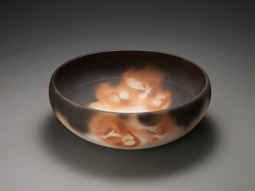 |
|
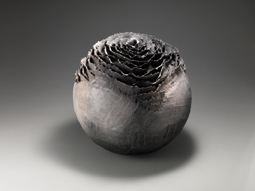 |
| The unique coloration and flame design of this Hagi ikebana bowl by Grand Prize winner Yu Okada (1946-) were rendered with a multi-step spray technique developed by the artist. |
|
Nobuko Nakamura (1945-) won the Merit Prize for her Earth of Flowers, a dynamically textured piece created by wrapping thin layers of clay around a paper core and firing the whole not in a kiln but outdoors, in a field. |
It's a wonder that Musée Tomo, which opened eight years ago in Tokyo's Toranomon district, remains such a secret gem among the city's many fine galleries. This preeminent venue for contemporary ceramics by Japanese artists occupies an historical hilltop location that exudes sense of place, the building and its interiors are designed and appointed with exquisite taste, and its glass-enclosed restaurant overlooks a serene garden graced by ancient trees and anchored at one end by the Seiyokan, a registered cultural property. It's an oasis for design enthusiasts of all persuasions, and now is a fine time to visit as the museum is running its fourth competitive biennale exhibition through June 26, showcasing the diverse talents of 49 potters aged 26 to 76.
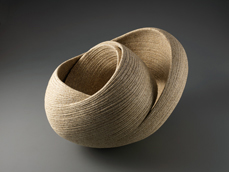 |
|
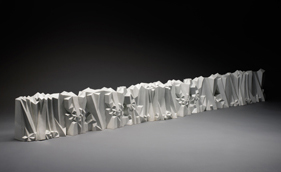 |
| One of five works to receive Honorable Mention, this Choto vessel by Takayuki Sakiyama (1958-) is the latest in the artistfs five-year quest to realize a seemingly endless, free-flowing form. |
|
Masafumi Shigeta (1985-), the youngest potter featured, had an architectural landscape in mind when he created White Porcelain Ore, a work of five separate pieces that together stretch over two meters (6.8 feet).
|
Situated on the crest of Edomizaka, a steep slope running behind the Hotel Okura and named for the sweeping view it once afforded of the castle town of Edo, Musée Tomo occupies a site that in medieval pre-Edo days was itself home to a castle. Today, visitors are greeted not by a fortress but by a sleek modern building sheathed in warm Israeli limestone, the design of Sakakura Associates. Adjacent to this is the Seiyokan, a circa-1924 wooden structure with its slate roof, stucco-and-brick façade, and original stained glass windows and furniture lovingly preserved. Normally closed to the public, the former industrial magnatefs residence will be opened twice during the biennale exhibition, on May 14 and June 18, when architect Yoshio Shinoda leads a tour followed by refreshments at the museum's restaurant. Reservations may be placed by calling the museum at 03-5733-5131.
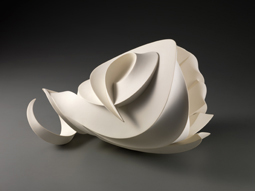 |
|
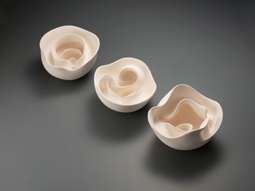 |
| A Form with Shadows by Takashi Ikura (1962-) displays the fine polished surfaces, liquid curves, and crisp edges that are this artist's trademark. |
|
The aptly named Velvet Skin by
Atsuko Tomaru (1964-) is a three-part study of sensuous curves. |
Owned by Tomo Kikuchi, a leading patron of Japanese ceramics, the museum proper is a sensory feast of form and texture. Ms. Kikuchi's personal collection of 300 pieces was received to great acclaim in 1983 at the Smithsonian Institution in Washington D.C. and London's Victoria and Albert Museum; in the twenty years between then and the founding of her eponymous gallery she expanded her collection as she planned its dramatic staging. From the entrance gate onward, we encounter metalwork by Shinichi Kitamura, calligraphic art by Toko Shinoda, and Naoto Yokoyama's textured glass handrail for the curving staircase that descends to the basement showrooms. These hand-crafted elements prime us to think about materials and design, the better to appreciate the rich mix of shapes, colors, and techniques found in the ceramics themselves. With very few exceptions, these are shown in theatrically lit open displays unencumbered by glass, enhancing the up-close, personal experience.
 |
|
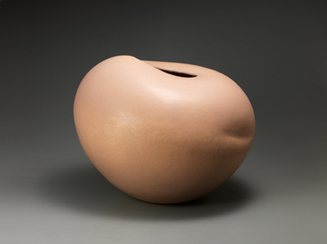 |
| Redolence by Takuro Kuwata (1981-) shows his penchant for lively colors and bright, happy designs. |
|
The softly hued Dream; Illusion by Michie Yamaguchi (1964-) received Honorable Mention for its assured balance of form. |
The exhibition's 49 ceramic works were selected by a panel of six judges in two blind screenings from 423 submissions, the largest competitive field in the biennale's history. By potters representing 22 of Japan's 47 prefectures, they fill the winding 370-square-meter (4,000-square-foot) gallery with an exultation of shapes, some stunning in size. For the first time this year, works were submitted by non-Japanese artists (from Korea and the United States), so it will be interesting to watch how the biennale's concept may change as its recognition among potters continues to grow beyond these shores.
Musée Tomo hosts regular seminars, conducted in Japanese, that are open to the public. On May 7, the biennale's five Honorable Mention recipients will gather as panelists; on May 28, art critic Kazuko Todate will lead a session exploring worldwide and domestic trends in ceramics curating and acquisitions. In addition, Saturday gallery tours with the curator will be held on May 21 and June 4 and 11.
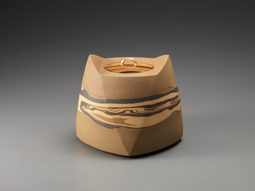 |
|
 |
| The only traditional tea utensil featured in the show, this water vessel by Saburo Tsukioka (1952-) has contoured angles that invite the subtle play of light and shadow -- a nuance suited to the art of tea. Its persimmon wood lid echoes the clay's nerikomi marbled pattern. |
|
Inside the main gate, the museum's stone-and-metal approach is a first cue to start thinking about design. At right is the Seiyokan, and beyond it the traditional Japanese garden that links the two buildings.
All artwork photographs by Shigeharu Omi, courtesy of Musée Tomo.
Museum photograph by Susan Rogers Chikuba, by permission of Musée Tomo. |
|